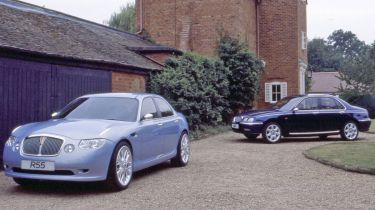Secret car that could have saved Rover
Sensational pictures show upmarket 400/45 replacement, 55 promised step up in quality, as true 3-Series rival
TAKE a look at the stunning BMW 3-Series rival from Rover that never was. This is the 55 – a striking sports saloon that was central to a plan to move the firm upmarket at the start
of the last decade.
Auto Express has gained exclusive access to sensational images from that time, which prove that owner BMW was looking at a post-retro future for Rover. This daringly proportioned model was designed to hit the market years before Chrysler’s conceptually similar 300C.
Back in the Nineties, Rover engineers and architects were hard at work on a replacement for the Honda-based Rover 400/45. This larger, more desirable model was to be badged the 55, and was intended to take the fight to premium saloons such as the Audi A4, Mercedes C-Class and, of course, the 3-Series.
In fact, this car was part of a planned two-model attack on the upper-medium segment, as BMW looked to take Rover upmarket. Bosses also intended to increase the size of the Rover 75’s replacement, so it would do battle in the same sector as the A6, E-Class and 5-Series.
The new 55’s unusual proportions were down to its underpinnings. It was to be powered by BMW engines in four and six-cylinder form, but most intriguingly, bosses planned for the front-wheel-drive car to use longitudinally mounted engines, in a similar way to front-driven Audis. The units were to be set a long way back in the chassis – as in the current A4 and A5 – with a four-wheel-drive system to be offered as well.
This styling model of the 55 was completed in spring 1997, and as our picture shows, it was photographed alongside a pre-production 75 for contrast. Both cars were penned by Richard Woolley – currently at Land Rover. Interestingly, the original 75 was styled from drawing board to full size in one hit, and signed off just weeks before BMW bought Rover.
But what became of the 55? In late 1999, the dual-model policy was axed. Top brass focused on the small hatchback replacement for the 200/25 – the Rover 35 – although that project didn’t come to fruition, either. It was a last-ditch attempt to keep hold of Rover when there was pressure from BMW’s board to offload the troubled UK subsidiary.
If nothing else, these pictures offer a fascinating glimpse into what might have been for Rover had BMW kept faith with it.
Find a car with the experts



